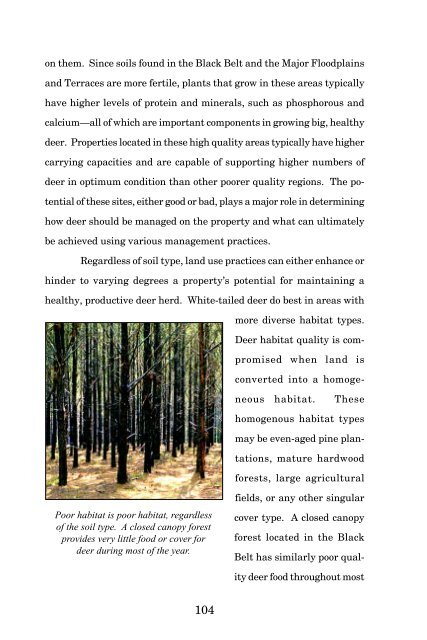Biology And Management Of White-tailed Deer In Alabama
Biology And Management Of White-tailed Deer In Alabama
Biology And Management Of White-tailed Deer In Alabama
Create successful ePaper yourself
Turn your PDF publications into a flip-book with our unique Google optimized e-Paper software.
on them. Since soils found in the Black Belt and the Major Floodplains<br />
and Terraces are more fertile, plants that grow in these areas typically<br />
have higher levels of protein and minerals, such as phosphorous and<br />
calcium—all of which are important components in growing big, healthy<br />
deer. Properties located in these high quality areas typically have higher<br />
carrying capacities and are capable of supporting higher numbers of<br />
deer in optimum condition than other poorer quality regions. The potential<br />
of these sites, either good or bad, plays a major role in determining<br />
how deer should be managed on the property and what can ultimately<br />
be achieved using various management practices.<br />
Regardless of soil type, land use practices can either enhance or<br />
hinder to varying degrees a property’s potential for maintaining a<br />
healthy, productive deer herd. <strong>White</strong>-<strong>tailed</strong> deer do best in areas with<br />
more diverse habitat types.<br />
<strong>Deer</strong> habitat quality is compromised<br />
when land is<br />
converted into a homogeneous<br />
habitat.<br />
These<br />
homogenous habitat types<br />
may be even-aged pine plantations,<br />
mature hardwood<br />
forests, large agricultural<br />
Poor habitat is poor habitat, regardless<br />
of the soil type. A closed canopy forest<br />
provides very little food or cover for<br />
deer during most of the year.<br />
fields, or any other singular<br />
cover type. A closed canopy<br />
forest located in the Black<br />
Belt has similarly poor quality<br />
deer food throughout most<br />
104
















